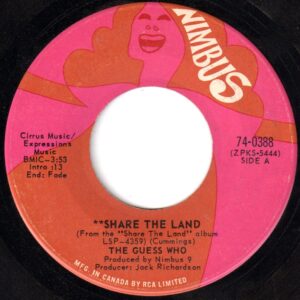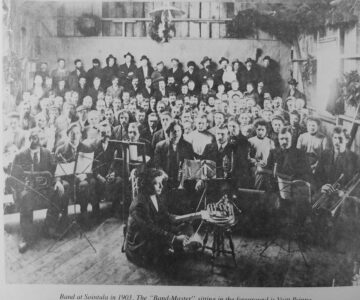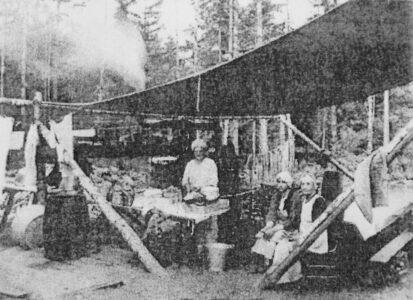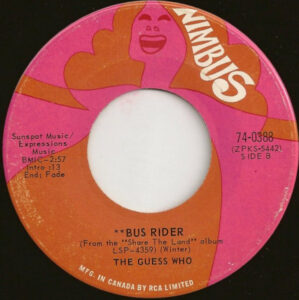#172: Share The Land/Bus Rider by the Guess Who
A-side: “Share The Land”
Peak Month: November 1970
9 weeks on Vancouver’s CKVN chart
Peak Position ~ #1
Peak Position on Billboard Hot 100 ~ #10
YouTube: “Share The Land”
Lyrics: “Share The Land”
B-side: “Bus Rider”
Peak Month: November 1970
9 weeks on Vancouver’s CKVN chart
Peak Position ~ #1
Peak Position on Billboard Hot 100 ~ did not chart
YouTube: “Bus Rider”
Lyrics: “Bus Rider”
Randolph Charles Bachman was born in 1943 in Winnipeg, Manitoba. When he was just three years old he entered the King of the Saddle singing contest on CKY radio, Manitoba’s first radio station that began in 1923. Bachman won the contest. When he turned five years he began to study the violin through the Royal Toronto Conservatory. Though he couldn’t read music, he was able to play anything once he heard it. He dropped out of high school and subsequently a business administration program in college. He co-founded a Winnipeg band called Al & The Silvertones with Chad Allan in 1960.
In 1962 the band became Chad Allan and the Reflections after some lineup changes. In addition to lead singer and guitarist, Chad Allen, and Randy Bachman on guitar, the keyboard player was Bob Ashley, on bass guitar was Jim Kale, and the drummer was Gary Peterson. Born in Winnipeg in 1943, Kale was still 18-years-old when he joined Chad Allen and the Reflections. Garry Denis Peterson was born in Winnipeg in 1945. He was 17-years-old when he joined the band. In 1962 they released “Tribute To Buddy Holly”, followed in 1963 by “Shy Guy” and in 1964 “Stop Teasing Me”. Later in 1964 the band changed its name to Chad Allen and the Expressions.
They had a hit in Canada in 1965 called “Shakin’ All Over”, a cover version of the original by the UK’s Johnny Kidd And The Pirates in 1960. Quality Records label credited the “Guess Who?” as the recording artist in an attempt to disguise the fact that the group was Canadian. Quality thought the record would be better received if they were thought to be a British Invasion act. The actual name, Chad Allan and the Expressions, was revealed a few months later. However, radio DJs in the United States and Canada continued to announce the group singing “Shakin’ All Over” as Guess Who?. This prompted a name-change to The Guess Who?
In 1965 The Guess Who? had a #3 hit the Canadian RPM singles chart with a cover of the 1961 Bobby Lewis hit “Tossin’ And Turnin'”. They repeated the feat with their third national Top Ten hit in Canada with “Hey Ho, What You Do To Me”.
Burton Cummings was born in Winnipeg, Manitoba, in 1947. When he was sixteen he dropped out of high school. In 1962, while only fifteen, Cummings founded a band named the Deverons. All members of the band learned to play by ear. Cummings played piano, saxophone and lead vocals. Their high school dance concerts comprised of covers of songs from the late 50’s and early 60’s including “This Time” by Troy Shondell, “Wild Weekend” by The Rebels, “Sheila” by Tommy Roe and “Only Love Can Break A Heart” by Gene Pitney. The Deverons released a couple of singles and Cummings got some positive word-of-mouth and reviews in the local Winnipeg papers. This was pretty exciting for bandmates who still all lived in their parents homes.
In January 1966 Cummings was asked to join The Guess Who?, when keyboardist Bob Ashley left the group. By May 1966 Burton Cummings became the lead vocal for the group when Chad Allen left to pursue solo work and host the CBC TV show Let’s Go. In 1966 The Guess Who? had a fourth Top Ten single on the Canadian charts titled “Believe Me“.
The Guess Who? tried to tour in the UK themselves in 1967 to support their single, “His Girl”. However, they didn’t have the proper documentation to perform, and “His Girl” only ended up spending one week on the British singles charts. A follow up single, “This Time Long Ago”, was a Top 20 hit in Vancouver later in ’67.
In the fall of 1967 The Guess Who? were hired as the house band for The Swingers, a local CBC radio show in Winnipeg. They also were hired as the house band for the TV show Let’s Go, also on the Canadian Broadcasting Corporation. That show was hosted by their former band-mate, Chad Allan. The group got exposure on the 39 weeks the show aired in both seasons (1967-68 and 1968-69). They performed hits on the Canadian charts like “Touch Me” by The Doors, “Time of the Season” by The Zombies, “You Keep Me Hanging On” by Vanilla Fudge, “White Room” by Cream and “Along Comes Mary” by The Association. They also were able to debut some of their own compositions including “Of A Dropping Pin, “Lightfoot, and “These Eyes”.
(Let’s Go also had a separate west coast show out of Vancouver. It was variously hosted by Terry Jacks, Tom Northcott, Mike Campbell and Howie Vickers, and featured appearances by The Seeds of Time, The Shockers, The Northwest Company, The Poppy Family and international stars like Eric Burdon & The Animals).
In the late ’60’s, The Guess Who? at this time consisted of Burton Cummings (keyboards, guitar, piano) Randy Bachman (guitar), Jim Kale (bass) and Garry Peterson (drums). While the Guess Who were performing weekly on Let’s Go they were approached by Jack Richardson, a record producer working at his own record company Nimbus 9. He pitched to the band an idea to join him in advertising recording effort for Coca-Cola. What unfolded was an album called A Wild Pair. One side of the album featured The Guess Who? while the other side were recordings of the Ottawa band, The Staccatos (who shortly afterwards renamed themselves as The Five Man Electrical Band). The album was only available for purchase through mail-order for the price of 10 Coca Cola bottle cap liners and $1 for shipping. Randy Bachman of The Guess Who recalled years later that he thought A Wild Pair may have sold many copies. However, as the LP was sold through this unorthodox mail-order scheme, it was not on the radar of those who certify record sales for albums.
Believing in The Guess Who?, Richardson went into debt to help them record their first studio album in September 1968 called Wheatfield Soul. It was released in March 1969 along with the debut single from the album, “These Eyes”. By 1969 the band dropped the question mark in their billing to be known as The Guess Who. In 1969 the band played before one of the biggest crowds at the Seattle Pop Festival. Other headliners on stage at that event were Led Zeppelin, The Doors, The Byrds, The Burrito Brothers, Frank Zappa and The Mothers, Alice Cooper, Bo Didley, Chuck Berry, Ike and Tina Turner, The Chicago Transit Authority.
On April 18, 1969, the Guess Who performed in concert at the PNE Agrodome in Vancouver. The following Sunday, April 24, 1969, the Guess Who appeared at the Vancouver Pop Festival in Paradise Valley, Squamish, BC. They shared the stage with Chicago, Lee Michaels, Little Richard, the Strawberry Alarm Clock, Taj Mahal, Canned Heat, Love, Sonny Terry & Brownie McGhee, the Grass Roots, Alice Cooper, Grateful Dead, Merilee Rush and the Turnabouts, the Byrds, the Chambers Brothers, and the Rascals.
In the summer of 1969 the Guess Who had their second #1 hit in Canada with “Laughing”. The B-side, “Undone”, was also a Top 30 hit. In January 1970 the band charted “No Time” to #1 across Canada and #2 in Vancouver. This was followed by the anti-war anthem “American Woman”. Though Burton Cummings would later state the song was just about preferring Canadian women to American women, the lyrics speak of larger issues: “I don’t need your war machines. I don’t need your ghetto scenes.” “American Woman” became the band’s biggest hit, and ironically was heard by some listeners as a song of adoration of American women. The Guess Who were invited to perform at the White House in July 1970. However, Pat Nixon instructed the band not to play “American Woman”, given her concern the lyrics would be understood as anti-American and anti-war. The latter being objectionable for a nation still at war in Vietnam. The B-side, “No Sugar Tonight” made the disc a double-sided number-one hit in Canada.
Randy Bachman left the Guess Who in May 1970. He was replaced by Kurt Winter, born in 1946 in Winnipeg. He was in a band called Brother. Gregory Leskiw, also born in Winnipeg in 1946, was from the band Wild Rice. Leskiw had begun learning guitar at the age of 12. Both Winter and Leskiw played guitar in the Guess Who.
Following upon their monster hit, the Guess Who had another Top Ten hit in Canada with “Hand Me Down World“, which climbed to #2 in Vancouver in August 1970. In the winter of 1970, The Guess Who had another Top Ten hit in Canada with “Bus Rider”/”Share The Land”.

“Share The Land” is a song advancing communal values of shared property among the common folk. Burton Cummings wrote the song. The singer asks the listener “Have you been aware? You got brothers and sisters who care about what’s gonna happen to you in a year from now?” Are we living our lives in isolation from one another? Are we competing with one another? “Have you done your share?”; “Did you pay your dues?”; “Do you know their names? Can you play their games?” asks the singer. Instead of the rat race and having to constantly keep up with the Joneses, the song offers an alternative: “Maybe I’ll be there to share the land that they’ll be giving away when we all live together.”
In this communal utopia, the singer promises “Now more sadness, no more sorrow, and no more bad times. Everyday come sunshine, everyday everybody laughing…walking by the river…Walking, singing, talking, smiling, laughing digging each other…” In the Biblical Book of Revelations, Chapter 21:4 states “he will wipe every tear from their eyes. Death will be no more; Mourning and crying and pain will be no more, for the old things have passed away.” In “Share The Land” there is a promised time to come where people will live communally and there will be an absence of the old things: no more sadness, no more sorrow, no more bad times. There isn’t even financial stress or worry. The land will be given away for free, and people will live together. They won’t be commuting to work. They’ll be “walking, singing, talking, smiling, laughing, digging each other.”
In the Book of Leviticus 25:1-13, the Biblical writers describe what is called the Year of Jubilee. This is an economic system where every fifty years everyone was released from their debts, all slaves were freed, and property was returned to those who owned it. In “Share The Land” the economic system and relationship to the land is one free of property ownership. People just live on the land for free, and make decisions communally. They also spend far more time just being together, and work is a secondary activity (which isn’t itself addressed in the song – but someone would have to get food, cook, clean…)
There were numerous examples of utopian communities in Canada that may have inspired Burton Cummings in writing “Share The Land”. In 1900, on Malcolm Island, east of Vancouver Island, British Columbia, was a colony named Sointula. The name meant “Place of Harmony” in Finnish. This utopian colony was established by Finnish immigrants and even though it was short-lived in that form, a community with a strong Finnish heritage and some co-operative institutions has continued for decades. The idea for Sointula originated in the Finnish temperance organizations of the 1890s associated with the coal mines of Vancouver Island. The working and living conditions led to high rates of drunkenness, debt and death. Miners had to move repeatedly from one mine to another and each time had to find or construct their own accommodation. Talk of an independent, stable community for Finns based on socialist-cooperative principles evolved into a decision by twenty Finns to start looking for the resources they would need to create a cooperative community.

Sointula band (1903)
Dissension within the community, and a fire that took the lives of eight children and three adults in 1903, led to a split in 1904. Half the colony moved 30 miles away to establish a new colony.
In Manitoba, there was Hun’s Valley. In the beginning, this was first, an ethnic Hungarian settlement established as a part of Paul O. Esterhazy’s attempt to create a “New Hungary” on the Canadian Prairies. While Hun’s Valley did not become a lasting centre of Hungarian influence, the settlement paved the way for the establishment of the Esterház colony and other Magyar settlements in the Prairie West. In 1885, Hun’s Valley was made up of 38 families recruited by Esterhazy from the eastern mining region of Pennsylvania. The land they were assigned was spread out. The Manitoba and North-Western Railway gave up three of its odd-numbered sections (17, 21, 33) in the valley of Stony Creek so de Döry’s settlers could build their houses more closely together. The railway company also provided a $4000 loan for the purchase of agricultural implements and farm animals. During the first winter the settlers gained supplementary income cutting cordwood and burning charcoal for the railway company. In subsequent years, they traded loads of poplar cordwood cleared from their land for supplies in Neepawa. In 1893, his colony consisted of 29 families, 122 people in all. They also had 60 horses and 200 head of cattle. Most of the original families gradually left after the death in 1895 of the colony’s leader, Géza de Döry. As well, an influx of Polish and Slovak immigrants to Hun’s Valley shifted the demographics. In 1921 the area was renamed Polonia.
In 1923, in Sooke, British Columbia, on the southern tip of Vancouver Island, was the Standfast Bible Student Colony, It was established by a group of 60 bible students from Alberta and Saskatchewan. The colony was one of many across North America by people who had banded together to give up their worldly possessions and live more simple lives, while await for the world to end and the second coming of Christ. The colony was founded on principles of love, justice, brotherly cooperation, and a desire to achieve greater spiritual progress. Up to 400 people lived mostly in tents.

Standfast Bible Student Colony, Sooke, BC (1923)
The community began to split up in 1926-27, due to a lack of funds. Some rejoined the mainstream of society, while others moved to Port Renfrew to continue living communally.
In “Share The Land” the Guess Who evoked a utopian dream, one that is harder to sustain in practice – if the experience of those who have tried to form communes is instructive.
“Share The Land” peaked at #1 in Winnipeg (MB), Vancouver (BC), New Haven (CT), Lethbridge (AB), Fort Lauderdale, Rochester (NY), Syracuse (NY), and St. Louis, #2 in Hamilton (ON), Chilliwack (BC), Portland (OR), Indianapolis (IN), Memphis, Hilo (HI), Minneapolis/St. Paul, and Columbus (OH), #3 in Louisville (KY), Welland (ON), Peoria (IL), Sioux Falls (SD), Chicago, Toronto, Babylon (NY), Montreal, Flint (MI), Saint Charles (MO), Portland (OR), and Moscow (ID), #4 in Reading (PA), Lancaster (PA), Allentown (PA), Edmonton (AB), and Wilkes-Barre (PA), #5 in Vancouver (WA), Toledo (OH), Newport News (VA), Green Bay (WI), Miami, Orlando, and Wilmington (DL), #6 in Pittsburgh, Eau Claire (WI), Birmingham (AL), Shreveport (LA), Cincinnati (OH), Kansas City (MO), Calgary (AB), and San Diego, #7 in Salt Lake City, Astoria (OR), Fresno (CA), Easton (PA), Greenville (SC), Lansing (MI), Seattle, Ann Arbor (MI), Youngstown (OH), and Boston, #8 in Bremerton (WA), #9 in Bellingham (WA), Waterloo (IA), and San Jose (CA).
“Share The Land” was the #20 hit of 1970 on CKLG, and ranked at #28 on CKVN in Vancouver. However, the song didn’t make the Top 100 for the year 1970 in Billboard magazine.
New bandmate, Kurt Winter, wrote the B-side “Bus Rider”.

The song describes a working class commute to work on a city bus. The bus rider leaves his house “the wife and kids,” at six o’clock in the morning, with his lunch pail. The line, “Better not get up or you might lose your seat,” depicts how crowded buses can be during rush hour. At the end of the day, he gets home and reads the evening edition of the newspaper. The work-a-day-world is stressful. The guy is losing his hair, so he has to grab a toupee. The narrator of the song is not a bus rider, as he observes “I’m so awful goddamn glad I’m not in your shoes.”
“Bus Rider” peaked at #1 in Vancouver (BC), and St. Louis, #2 in Hamilton (ON), #3 in Welland (ON), and #6 in Calgary (AB) and Vancouver (WA). As part of a double-sided hit in Vancouver, “Bus Rider” also was ranked #20 for the year 1970 on CKLG Top 173 of 1970.
In 1971 the Guess Who had another Top Ten hit in Canada with “Hang On To Your Life”. The song’s lyrics offered a message advising against taking illegal drugs. The album version of the song concluded with Burton Cummings reading Psalm 22: 13-15. It included these words: “my bones are out of joint… My strength is dried up like a potsherd; and my tongue cleaveth to my jaws; and thou hast brought me into the dust of death.”
The next single release in 1971 by the band was the non-album disc “Albert Flasher”/”Broken“. The followup single, “Rain Dance” became the twelfth Top Ten single for The Guess Who in Canada. The B-side, “Sour Suite” was also a Top 20 hit in Canada. In the fall of 1971, The Guess Who released “Life In The Bloodstream”, which peaked at #4 in Vancouver. All three songs were from the Guess Who’s eighth studio album So Long Bannatyne. While the Guess Who gave a concert at the PNE Agrodome on October 15, 1971.
In 1972 the band had more Top Ten hits in Canada with “Heartbroken Bopper” and “Running Back To Saskatoon”. The Guess Who went on tour with Three Dog Night in November and December 1972 to Japan, New Zealand, and Australia. The following year “Follow Your Daughter Home” and “Glamour Boy” kept the band on Top 40 radio.
In 1974 The Guess Who pulled out of their slump with a Top Ten hit across the continent, “Clap For The Wolfman”, a tribute to the famed rock ‘n roll DJ. A followup single from Road Food, “Star Baby”, was a Top Ten hit in Canada. However, after their album, Road Food, the band went back into a slump with fans taking a pass on further album releases into 1975-76. On August 26, 1974, and again on August 16, 1975, the Guess Who performed concerts at the Pacific Coliseum in Vancouver. The Guess Who officially split up in October 1975. Burton Cummings went solo.
On May 20, 1978, the Guess Who appeared at the Pacific Coliseum in Vancouver for a concert. And on June 23, 1983, the Guess Who returned to give a concert at BC Place Stadium in Vancouver.
Over the decades since their breakup, The Guess Who have performed at reunion concerts and tours. Meanwhile, former bandmate Randy Bachman, quit the band in 1970. He went on to form Bachman-Turner Overdrive, which was commercially very successful through the mid-70s. Bachman subsequently launched a solo career. Since 2005, Randy Bachman has been a host of Vinyl Tap,a show on CBC Radio where he plays sets of pop tunes and discusses some of the details he knows about the performers and musicians he’s met. In 2008 Randy Bachman was awarded the Order of Canada.
On June 24, 2000, the Guess Who appeared in concert in Vancouver at General Motors Place. The Guess Who last performed in concert in Vancouver at the Pacific Coliseum on August 7, 2001.
June 13, 2022
Ray McGinnis
References:
Contributions from John Einarson and Burton Cummings, The Guess Who, Manitoba Music Museum, Winnipeg, MB, 2012 and 2016.
Ivor Levene, “Rearview Mirror: Burton Cummings Reflects on The Guess Who,” Relix.com, New York City, June 20, 2016.
Leslie Michele Derrough, Burton Cummings of the Guess Who (Interview), Glide, January 26, 2015.
“Sointula: 1901-1905,” Canadian Utopias Project.ca.
“Hun’s Valley, Manitoba,” Canadian Utopias Project.ca.
“The Guess Who – concerts – Canada,” setlist.fm.
“Your Average Rock & Roll Radio Survey,” CKVN 1410 AM, Vancouver, BC, November 27, 1970.
“CKLG Top 173 of 1970,” CKLG 730 AM, Vancouver, BC, December 31, 1970.
For more song reviews visit the Countdown.

I am a fan of the Guess Who. I was recently listening to “Bus Rider” and noticed quite a lot of similarities to “Paperback Writer” released 4 years earlier by the Beatles. I’ve never seen anyone write about this. Any comments?
Thanks!
That’s funny. I always felt Bachman’s (BTO, 1973) “Taking care of Business” – ironically an idea (“Whitecollar Worker”) he proposed to Cummings, who shot it down as being too similar to “Paperback Writer” – was similar to “Bus Rider”.